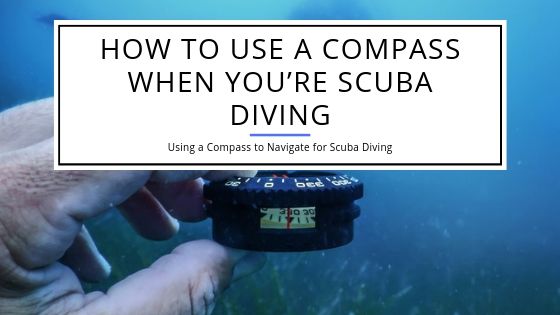How to Use a Compass When You’re Scuba Diving
Many people crave the thrill of underwater exploration. Diving deep beneath the surface, swimming with mysterious creatures, and enjoying stunning views is certainly exciting. However, when you are actually down there, surrounded by nothing but blue on all sides, it is easy to feel overwhelmed and lose your way. Did you pass by that reef already? Who knows! It looks exactly the same as the other ones you just swam by. Sometimes, natural navigation needs some support through technical means, namely to use a compass when you’re diving!
Losing your way is dangerous even on land, but underwater, it can be truly terrifying. Even if you are not afraid, it can be inconvenient if you miss your target and swim farther away, and you’d waste a lot of energy backtracking.
To avoid that, divers use special compasses designed to work underwater. However, since the environmental conditions there are different, this life-saving piece of equipment is also not as simple to use as a regular land compass. Figuring out how to use one by yourself can be difficult and confusing, but with this comprehensive guide on how to use a compass for underwater navigation, no diving compass will ever be a mystery to you.
How does a compass for scuba diving work?
A scuba diving underwater compass is still just a device that helps you with underwater navigation. It usually has a round face that contains the four cardinal directions: north, south, east, and west. There are also guiding ticks or numbers evenly interspersed between these four. The numbers correspond to the degrees in a full circle and go from 0 to 360.
One of the most important parts of a normal compass is the needle – a moving arrow that points north. All compasses can always find where magnetic north is because of the Earth’s magnetic field.
The needle in a scuba diving compass, however, is usually painted on the card. The entire card is floating and spinning inside the corpus of the device so that it can orient itself when surrounded by moving water. Still, the card of the compass will feature an easy-to-spot shape that is similar to the needle in normal compasses, which you have to pay attention to.
When you know where true north is, it’s easy to find your way when you use a compass for underwater navigation, especially when you rely on the ticks or degrees along the bezel for the compass navigation. This might seem complicated at first, but once you get to know all of the parts of your diving compass, it will all begin to click.
Can you use the same compass as you use on land?
It is not impossible, but it is not recommended. It may not be of much use, depending on the conditions of your dive and your overall navigation skills.
Even though both land and diving compasses respond to the planet’s magnetic field, the pressure underwater is different. Not all land compasses can survive a deep dive. Even if a land compass claims to be waterproof, that usually means that it can take some light water exposure. It might be fine if it falls into a stream during a hike, but that doesn’t mean it would do well in an extended dive. Moreover, a regular compass is more difficult to read underwater due to the lack of an easy-to-follow guide, such as the lubber line or the bezel.
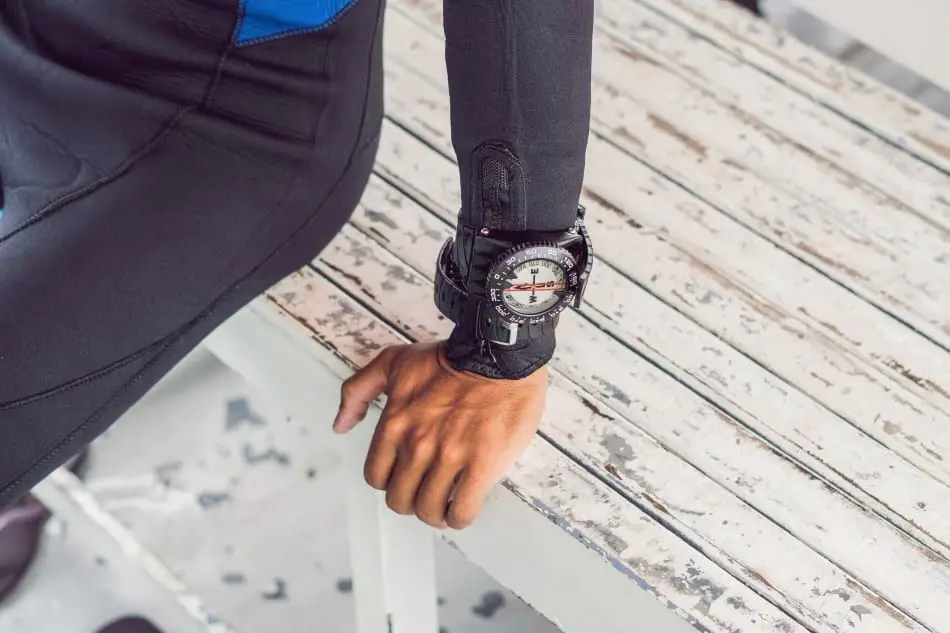
What are the components of a compass?
Card
The card is the free-floating face of the compass. It shows the four cardinal directions with degrees in between for a more accurate sense of direction. The needle is painted onto the card, so the entire structure rotates when it’s trying to find magnetic north.
In order to have an accurate reading of your bearings, you need to keep the card level. This is why a diving compass is mounted and positioned in a certain way. You must always ensure you are reading it horizontally and that you are not tilting it to the side.
Lubber line
The lubber line is a red (or sometimes black) line painted onto the compass. It never moves, and its purpose is to give you a clear pointer.
To take a heading, you need to point the lubber line at your target. When you are underwater, always try to align your body with the lubber line so that it points in the direction you are moving.
When pointing at your target, the line will also overlap with a certain degree on the bezel. Remember the numerical value of your heading, in case you stray from your path and need to find it again.
Bezel
The bezel is a ring with degrees surrounding the card.
To help you find your way more reliably, the bezel usually has two symmetrical bold ticks. You need to align them with the north-pointing needle once it settles. When your compass is level, and the needle finds north, you have to rotate the bezel until north falls between the two index ticks. That way, the 0 on the bezel will equal true north.
When you begin swimming towards your destination, keep an eye on the bezel. If you notice that the north measurement is moving outside of the index markings, it means you’ve turned more than you needed to. You have to stop, find north, and align the index markings to it again. Afterward, turn until the lubber line points to the same tick or degree from your initial heading.
Side window
Because you need to keep your diving compass level, it is easier to read it horizontally. For this reason, there is a window on the side of the compass that provides you with an eye-level reading. The lubber line extends to this window so that you can still follow it. Additionally, the side window contains a numerical reading from the card, in case you need the extra information to get your bearings.
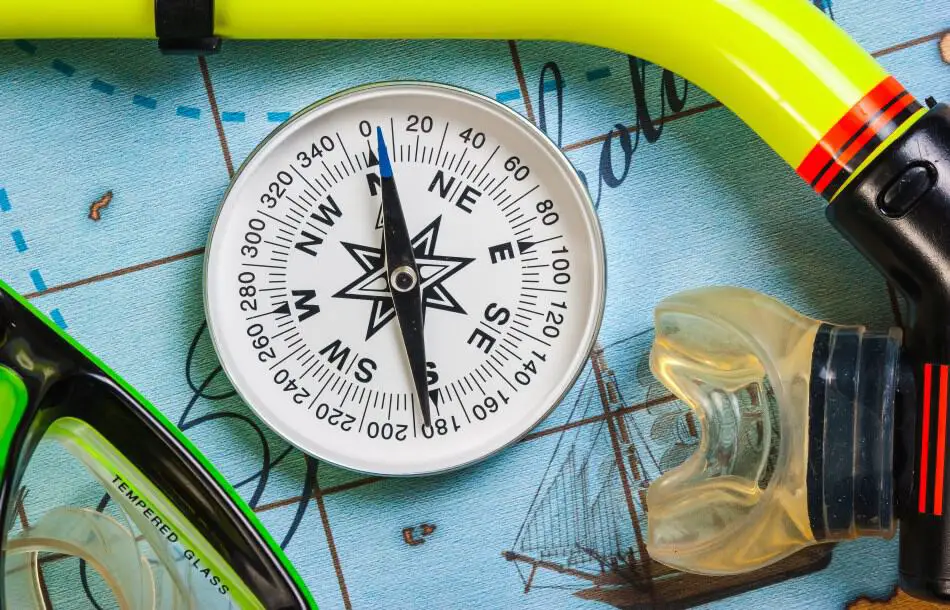
How exactly do you have to follow the numbers on the compass?
The numbers on your compass are there to help you by indicating in what direction you are moving. That being said, it is nearly impossible to follow a number precisely. If your target is not very far away, even if you are a tick or two off of your original goal, you will most likely still make it to your destination just fine.
However, as distances increase, so does the range of what lies between every two numbers on your compass. If you plan to travel a great deal underwater, sticking to the numbers will be extremely important.
Just use the main direction points, to begin with
For most short trips or recreational dives, you won’t need to worry about all the numbers on the bezel for your compass navigation. The main directions will coincide with 90-degree intervals, with north at 0, east at 90, south at 180, and west at 270 degrees on the dial.
It can also be helpful to note the ticks that mark important midpoints between these measurements (30, 60, 120, etc.) for fine-tuning. But even if you don’t bother with the number on the bezel, you can count the ticks and remember your direction that way. If you point your lubber line towards the goal and see that it aligns with two ticks to the right of the north, you can just think of that as N +2, for example.
Follow the numbers if you’re getting the hang of it
While it’s not mandatory to rely on the numbers on your compass, if you find that it makes more sense to you and you don’t get easily confused by degree measurements, by all means, follow the numbers! They are there to help you, after all. Sticking to the cardinal directions and important ticks is easier for less experienced divers. Still, if you are already used to your compass, there’s no reason not to utilize it to the fullest.
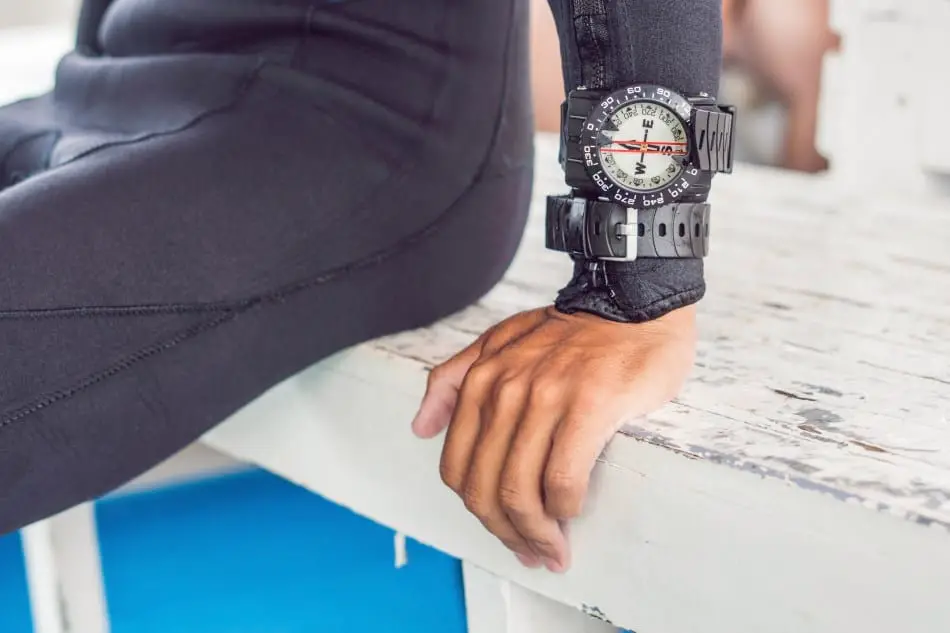
How do you use a compass underwater?
Handling a diving compass is a bit trickier than handling a regular one. If you look at the face of your compass the way you would on land, but you’re underwater, you might be headed straight into trouble when only relying on compass navigation. Because the card is floating inside the compass, looking at it from above would not tell you if the card is perfectly horizontal, and you will get skewed readings when you use a compass.
How do you hold it?
First off, you need to position the compass in front of you. You cannot look at it from above, for reasons previously explained. Instead, you want to align it with your field of vision so that the compass is between your eyes and your target destination.
Make sure the card is perfectly flat when you use a compass. This is where the side window comes in handy: it will allow you to see the card from the side. Once it’s level, you should be able to see the lubber line pointing to a degree. That’s your direction.
Hopefully, you took a heading before getting in the water and know to compare that with whatever value the lubber line is pointing to – they should be the same number.
Find the heading
Align your body with the lubber line when using a compass. In fact, imagine the line as an extension of your body.
First, set up your compass correctly, allowing the needle to find north, and then aligning the bezel’s north index markings with it. Once that’s done, simply point your compass in the direction of your target. For example, if you’re planning to swim to an island, you can get above water, see where the island is, and point the lubber line at it. All you have to do underwater is to keep following the line.
Keep on track by the numbers
The lubber line is great at guiding you towards your target. However, if your body is not perfectly straight, you may actually be moving slightly sideways. This is why the line is accompanied by a numerical value.
Remember that value when you first pointed your compass at your goal? If the needle is still inside the index markings, the lubber line should be pointing at the same value. If it’s not, you have to realign the bezel just like described above and spin until the lubber line is pointing at the correct degree again.
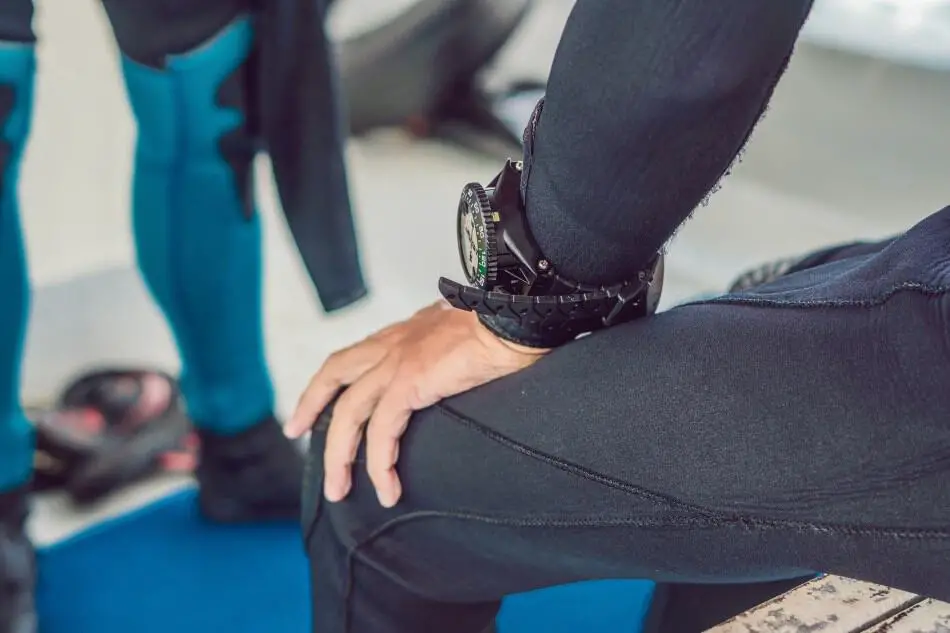
Navigating by the numbers
In some cases, you might be perfectly able to reach your target without relying on the numbers too much. However, they will be your best friend in several situations, including coming back to the point of origin.
How do you find your way back?
Let’s imagine that you had been diving for a while and reached your goal with your lubber line at, say, 120 degrees. To get back, you need to do some math before you use a compass.
You can either add or subtract 180 degrees. The numbers always add up to 360 in total, so if you want to avoid working with negatives, remember it this way: if your goal was at a degree less than 180, add. If it was above 180, subtract. Since your goal at 120 is less than 180, you need to add 180 to it and get 300. That’s your way back (also known as your reciprocal heading).
Don’t worry about the addition/subtraction too much. If you can’t remember when to do which, just stick to addition. If you get a sum over 360, subtract 360 from it and you get the reciprocal heading that you can then follow with your compass instead of somehow trying to use natural navigation.
Crossing a current without steering off-course
Underwater currents are perfectly natural, but they can be annoying if they push you off-course. If you get caught in a strong current during your dive, you need to turn upcurrent and swim in that direction until you cross the current.
Be mindful that this detour could steer you off-course. That’s why you need to check if the needle is still locked between the bezel’s index markings.
Diving a box course
This is a great exercise for training your overall navigation skills. Imagine you are swimming inside a square box, and you start at one vertex. To cover all four sides and return to the point of origin, you’d need to swim straight ahead and then do 90-degree additions every time you need to turn.
The cardinal points are located at 0, 90, 180, and 270, but you probably won’t start off at 0. To dive a box course starting from 40, for example, you’d need to turn right at 130, 220, and 310 instead.
To complete the box course by only turning right, you need to rely on addition. Conversely, if you want to complete the exercise with left turns, do subtraction. This is a good, simple way to get used to the numbers when you use a compass.
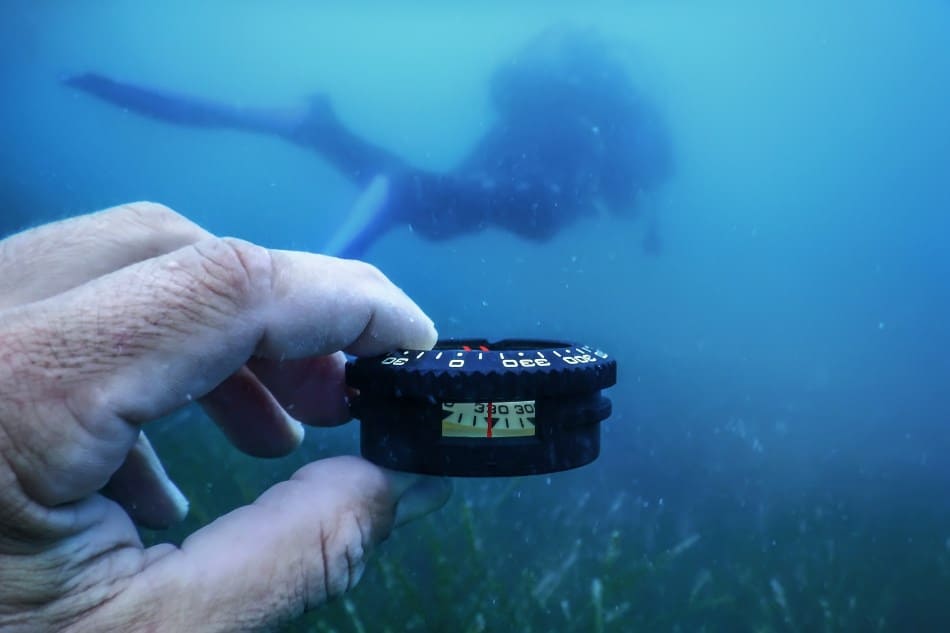
Where do you mount the compass?
As mentioned above, the position of your underwater compass is absolutely crucial if you want it to work correctly. Simply holding it in your hand won’t make it stable enough for you to get an accurate reading. This is why diving compasses are mounted in various ways.
Wrist mount
A wrist mount means that your compass is attached to your wrist, similar to a watch. However, you can’t just look at it from above as if you are checking the time. You need to read it horizontally, remember?
To do that, extend both arms in front of you. Now use the arm where your compass is to grab onto the elbow of your other arm. You are trying to form 90-degree angles between your hand and your elbow. This should give you enough support to steady the card within the compass. You can then get a reliable reading through the side window.
Console
Using a wrist mount might seem convenient, but it’s not a foolproof way to handle your compass. It can cause issues with buoyancy since your body is off-balance and your arm might be tilting the card. It is safer to mount your compass on a console — a physical structure that you can hold with both hands in front of you as you swim. This will help with your posture and will make following the lubber line feel more natural.
Integrated into a dive computer
If dealing with a mechanical compass seems like too much of a hassle, you could just opt for a dive computer instead. A dive computer is a small digital device that offers various important readings to the diver, such as depth, pressure, and more. Many dive computers made today also include a compass, eliminating the need to carry multiple devices with you.
A few last tips
Remember that your compass is not the only way to orient yourself in the water. Natural navigation is just as useful, especially if you are in an area with many unique features. Keep an eye out for anything noteworthy, such as rocks, reefs, and other structures that can guide you as you swim. For instance, if your lubber line is pointing at a rock, you can swim towards it without looking at your compass.
Please note that while an underwater compass is different from a regular one, it still works even when it’s not underwater. For the sake of your own safety, learn how to use your diving compass by practicing on land. As long as you don’t form a bad habit of looking down on your diving compass, this little exercise would be of great help when you finally step into the water.

